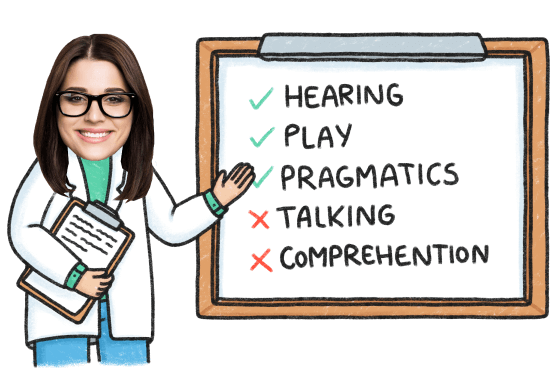Temper Tantrums vs. Meltdowns: Spot the Difference
Feb 14, 2022 As adults and parents, we often use the terms “Temper Tantrum” and “Meltdown” interchangeably. But the truth is that the two are actually very different things.
Learning the differences between the tantrums and meltdowns can help you to better understand why your child is having them and how to deal with them as parents. So today we’ll help you to distinguish the difference.
What is the Difference between a Tantrum and a Meltdown?
The truth is that tantrums and meltdowns can both look very similar. In each, a child may throw themselves on the floor, hit, kick, scream, or even hold their breath. The difference between tantrums and meltdowns then isn’t in the behavior, it’s in the reason behind the behavior.
What is a Tantrum?
Tantrums usually start in late infancy or early toddlerhood and are an expression of a want or a need. They may symbolize that a child is tired, hungry, sad, angry, or upset. Because children of this age often lack the vocabulary needed to express how they feel, and so they release their emotions as tantrums instead.
As a child becomes older, tantrums can also be used as a way of testing limits. While young infants and toddlers don’t yet understand manipulation and have tantrums as a result of expression, older children may use tantrums to manipulate their parents into getting what they want. If not dealt with at a young age, this behavior can extend well into the teenager years, becoming more severe and difficult as a child ages.
Tantrums are an expression of a want or a need.
When a child has a tantrum, they still maintain some measure of control over their behavior. Many researchers have found that if there is no audience, a tantrum will subside relatively quickly. Meltdowns are a little different . . . .
What is a Meltdown?
Unlike tantrums that occur as a result of an expression of need or want, meltdowns are a result of sensory overload. In other words, meltdowns occur when a child is feeling overwhelmed.
Meltdowns are a result of sensory overload.
Unlike tantrums which are goal-oriented, meltdowns cannot be controlled. They can be a result of emotional, physical, sensory, or information overload, and will occur with or without an audience. In some cases, complete shutdown or withdrawal can also result.

Who Has Tantrums vs. Who Has Meltdowns?
Tantrums are a completely normal part of childhood. They generally start when a child is nearing the end of their first year or entering into their toddler years. Tantrum behaviors commonly continue into the 3’s, and in some cases may extend even further (depending on how they have been managed).
Typical children can also have complete meltdowns, but they are not as common as tantrums. Frequent meltdowns can actually be a sign of an underlying condition. Research has found, for example, that regular meltdowns are closely associated with conditions like sensory integration disorder, developmental traumas, learning disabilities, depression, ADHD, fetal alcohol syndrome, and autism.
What is the Difference Between a Meltdown and a Tantrum?
As previously mentioned, tantrums and meltdowns can look very similar. So how can you tell the difference between the two?
1. Determine the underlying cause
If you can determine what is causing the behavior, you can then determine whether it is a tantrum or a meltdown. Ask yourself – is it goal oriented?
For example, if you are in the middle of a mall and your child starts screaming because you said “no” to getting a new toy, this is goal-oriented. Their goal is to get the toy that they so badly want. In return, you can assume that your child is having a tantrum.
But if you are in the middle of a mall and your child starts to lose their calm for no apparent reason, this could be a result of a sensory meltdown. Maybe there were too many people walking by or the noise was too loud for them. Whatever the reason, there is no end “goal,” just the behavior.

2. Does the behavior subside if you walk away?
When it comes to tantrums, one of the best things that you can do is walk away (but keep the child in your vision) and let your child calm on their own. In most cases, walking away from a tantrum will minimize the behavior. In other words, tantrums often require an audience.
Meltdowns don’t. A child will continue to have a meltdown whether there is an audience or not. This is because they are on overload – they simply don’t know how to handle everything going on inside of them. Unlike tantrums, emotional explosions in the form of a meltdown can occur even without your presence.
3. Does distraction help the behavior subside?
If your child is having a tantrum, you can often distract them with other things. Though we don’t recommend giving in to a tantrum, we can use it as an example. If you were to give in to a tantrum, the poor behavior associated with it would probably stop immediately. But there is no “giving in” with a meltdown. In the case of a meltdown, once it has been triggered, there is no distraction strong enough to stop it.
Boost Your Child’s Speech Development!
Improve language & communication skills with fun learning!

How to Deal with a Tantrum or a Meltdown Behaviour
Tantrum
First, stay calm. The best way to deal with a tantrum is to ignore it. Yes, we understand that this can sometimes be difficult to do (especially if you are in a public place), but giving into the behavior will just escalate it in the future.
Meltdown
The best way to deal with a meltdown is to prevent it from occurring in the first place. Remember, once a child is having a meltdown they have already lost control. Aside from keeping them safe during the meltdown, there’s not much you can do because they are unlikely to hear you anyways. The goal then, is to prevent meltdowns in the first place. How do you do this?
- By establishing calming routines (i.e., visuals, music, sensory balls, etc.) that a child can use when you sense that they are becoming overwhelmed or overstimulated.
- By mapping the patterns of behavior that your child displays before entering into a meltdown, and understanding and avoiding your child’s triggers.
In the case of both meltdowns and tantrums, teaching your child how to communicate their feelings appropriately can also be very helpful. Children who don’t yet have the tools to communicate that they are feeling upset, or angry, or sad, or overwhelmed are more likely to engage in tantrum and meltdown behaviors than children who do have the language skills to communicate properly.
You can help your child to develop the skills that they need to communicate effectively with an app like Speech Blubs. Speech Blubs uses a variety of different tactics and activities to help children learn new sounds and words, and has been speech therapist approved. It is designed for both typical speakers, as well as for those will special needs like Autism.
If we can help our children communicate, we can reduce tantrum and meltdown behaviors – so why not give it a try today?

